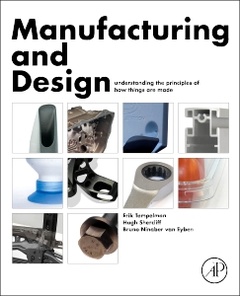Description
Manufacturing and Design
Understanding the Principles of How Things Are Made
Authors: Tempelman Erik, Shercliff Hugh, van Eyben Bruno Ninaber
Language: English
Subject for Manufacturing and Design:
57.91 €
In Print (Delivery period: 14 days).
Add to cart310 p. · 19x23.3 cm · Paperback
Description
/li>Contents
/li>Biography
/li>Comment
/li>
Manufacturing and Design presents a fresh view on the world of industrial production: thinking in terms of both abstraction levels and trade-offs. The book invites its readers to distinguish between what is possible in principle for a certain process (as determined by physical law); what is possible in practice (the production method as determined by industrial state-of-the-art); and what is possible for a certain supplier (as determined by its production equipment). Specific processes considered here include metal forging, extrusion, and casting; plastic injection molding and thermoforming; additive manufacturing; joining; recycling; and more.
By tackling the field of manufacturing processes from this new angle, this book makes the most out of a reader's limited time. It gives the knowledge needed to not only create well-producible designs, but also to understand supplier needs in order to find the optimal compromise. Apart from improving design for production, this publication raises the standards of thinking about producibility.
Introduction
Product Disassembly Studies
Shape Casting of Metals
Sheet Metal Forming
Extrusion of Metals
Forging of Metals
Machining
Injection Molding of Thermoplastics
Thermoforming
Resin Transfer Molding
Additive Manufacturing
Joining and Assembly
None of the Above
Recycling
Manufacturing Process Choice
Hugh Shercliff is a Senior Lecturer in Materials in the Department of Engineering at the University of Cambridge. He is a co-author of Michael Ashby's Materials, Third Edition (Butterworth-Heinemann, 2013), and a contributor on aluMATTER, an e-learning website for engineers and researchers sponsored by the European Aluminium Association.
Bruno Ninaber van Eyben graduated with distinction in the design of plastics and metals at the Maastricht Academy in 1971. Since then, he has designed many iconic products, from coins to the gavel used by the Dutch Parliament. Today, he divides his time between his own Studio Nanaber and a part-time professorship at Delft University of Technology, Industrial Design Engineering.
- Emphasizes the strong link between product design and choice of manufacturing process
- Introduces the concept of a "production triangle" to highlight tradeoffs between function, cost, and quality for different manufacturing methods
- Balanced sets of questions are included to stimulate the reader's thoughts
- Each chapter ends information on the production methods commonly associated with the principle discussed, as well as pointers for further reading
- Hints to chapter exercises and an appendix on long exercises with worked solutions available on the book's companion site: http://booksite.elsevier.com/9780080999227/

